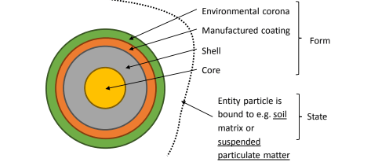Nanomaterial form and state
Nanomaterials may be present in the environment in numerous forms and states:
- Form describes the structure and composition of the nanomaterial at the level of the individual particle, as for example whether the particle has a manufactured coating, an environmental corona of adsorbed material such as natural organic matter, or a shell whose physicochemical properties are different to those of the core. (Note, the shell may exist as a manufactured feature of the particle, or as a result of chemical transformation during the particle lifetime).
- State describes the physical state of the nanomaterial in the environment, for example whether it is present as free particles, aggregated to suspended sediments in waters, or bound to the solid matrix in a soil.
The form and state of a nanoparticle is key to its fate. For example: (i) particles heteroaggregated to suspended sediments in waters are subject to transfer to the bed sediments if the suspended sediment is deposited out of the water column; (ii) particles having an environmental corona may have modified surface properties that reduce their tendency to heteroaggregate to suspended sediments or soils.
Not all types of nanomaterials may adopt all the possible forms and states – for example, not all particles are manufactured with a surface coating.
The NanoFASE water-soil-organism model keeps track of the amount of material in each separate possible form and state, as well as of the transformations of particles from one combination of form or state to another.
Transformations
Transformations include, but are not limited to, coating degradation, dissolution, chemical alteration (e.g. sulfidation), environmental corona formation and heteroaggregation. The models allows detailed calculation of transformations within each of the separate environmental compartments (e.g. soil, or river).

Conceptualisation of general nanoparticle structure within the NanoFASE model
Read more |
|
|
NanoFASE Report D2.1 Specification for the NanoFASE model |
Contact

Sam Harrison
Centre for Ecology and Hydrology (CEH)
